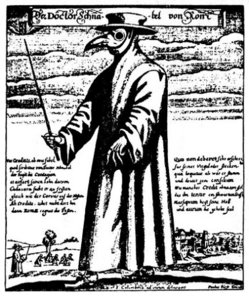Myron Echenberg. Black Death, White Medicine: Bubonic Plague and the Politics of Public Health in Colonial Senegal, 1914-1945. Portsmouth, N.H.: Heinemann, 2002. xviii + 303 pp. Glossary. Illustrations. Photographs. Appendix. Bibliography. Index. $69.95. Cloth. $28.00. Paper.
Black Plague, White Medicine is a compelling monograph that implicates the political career of Biaise Diagne, the outbreak of World War I, and shifting urban landscapes in the bubonic plague's development in twentieth-century Senegal. Myron Echenberg demonstrates successfully that the history of colonial public health in Africa is embedded in a larger history of struggles for power on local, metropolitan, and global levels. The book is a welcome addition to the social history of medicine and health in Africa, a field Echenberg acknowledges as "a burgeoning industry" (5), yet one that is marked by the conspicuous absence of work on the bubonic plague in Africa. Echenberg also makes the point that with a few article-length exceptions, French colonial medicine has been neglected in historical research-although Eric Silla's book on leprosy in Mali, People Are Not the Same (Heinemann, 1998), is a recent notable exception.
Echenberg leads the reader through three distinct sections, dealing respectively with the 1914 outbreak in Dakar and its developments through the end of World War I, the interwar social and economic impact of the plague, particularly in regions such as Rufisque and St. Louis, and the last years of the epidemic and its retreat at the end of World War II.
Part 1 is the strongest, containing rich primary material as well as Echenberg's most forceful arguments. Here he underscores the significance of urban expansion to the course of the epidemic, arguing that the politics of the colonial city, rather than epidemiological concerns, influenced responses to the plague. The French colonial administration responded to the 1914 outbreak by enforcing curfews for Africans and segregating the city into African and French quarters, arguing that Africans spread the disease through poor hygiene. Mass burials and the cremation of bodies ravaged by the plague were required of all African plague fatalities, and African survivors were forced to comply with strict, and at times extreme, vaccination and sanitation measures. Many Africans interpreted French response to the epidemic as an attempt to curb African political action, including the election of Biaise Diagne to the National Assembly. Local healing practices were discredited, and public meetings and freedom of movement were highly restricted for Africans.
The last two parts of the book address the plague's effects on the Senegalese hinterland as well as St. Louis and Rufisque, and the last plague epidemic in 1944. Echenberg's main arguments here are that the interwar period saw no improvement in French medical treatment of the plague. Sanitation and prevention methods continued to be severe, placing the blame on the victim, an abusive practice that Echenberg argues persisted until the postcolonial period in Senegal. When the plague raised its head again in 1944, it was smothered with DDT and sulfa drugs, therapies brought to Senegal as a result of the American military presence at the end of World War II. Here, Echenberg points out that differences in medical technologies were not all that distinguished the first outbreak of 1914 from the outbreak of 1944. Subdued resistance to antiplague treatment reflected fatigue on the part of local African communities in Senegal after thirty years of brutal plague control methods. By the mid-1940s, Echenberg suggests, people endured precautions against plague as another material hardship of the colonial experience.
Containing oral testimony and photographs documenting plague outbreaks and treatment methods, Black Plague, White Medicine is a well-produced study. It is suitable for teaching at undergraduate and graduate levels, particularly in courses on urban history and public health and society.
Emily Burrill
Stanford University
Stanford, California
Copyright African Studies Association Sep 2003
Provided by ProQuest Information and Learning Company. All rights Reserved


